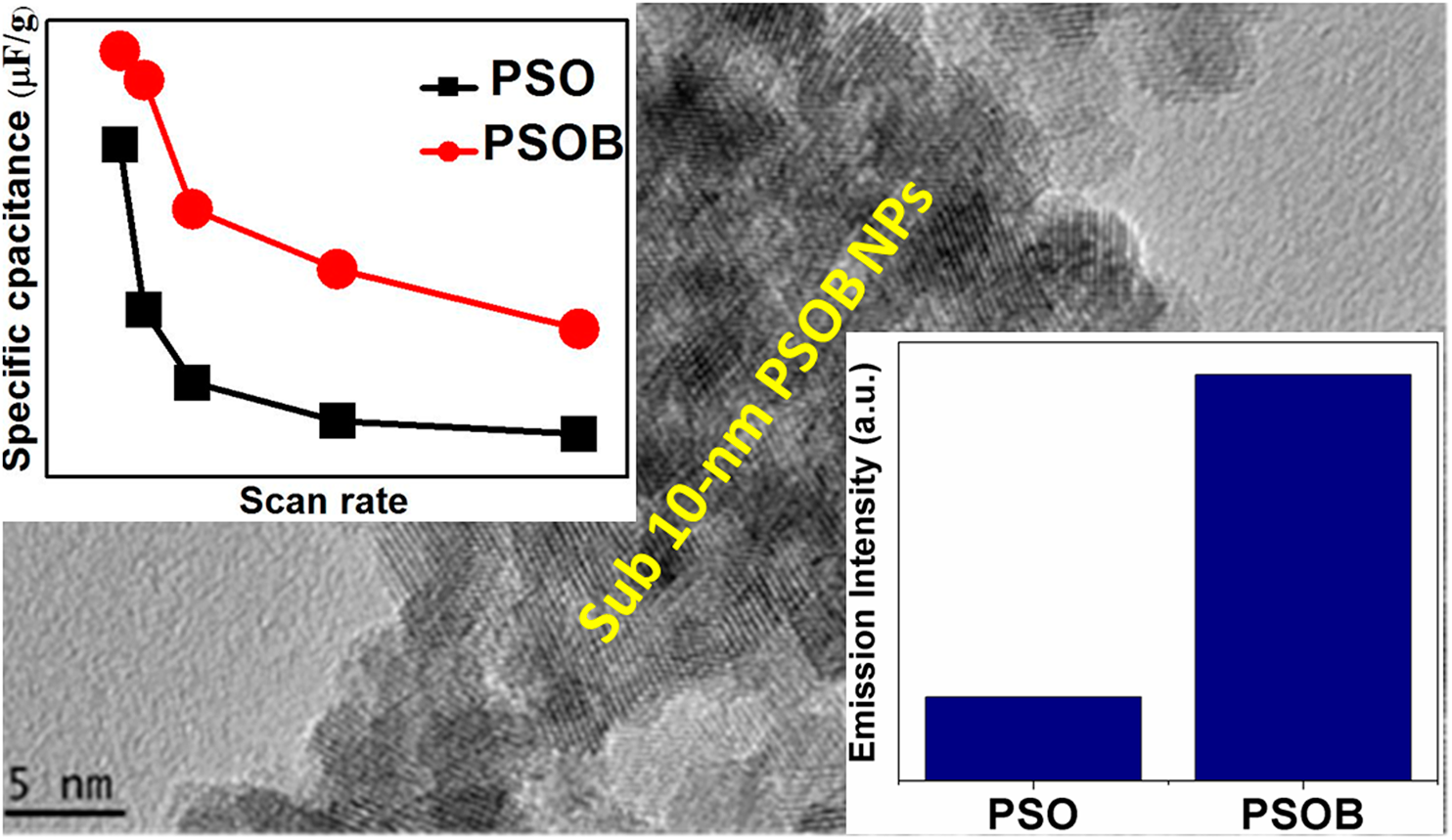Crossref Citations
This article has been cited by the following publications. This list is generated based on data provided by
Crossref.
Gupta, Santosh K.
Sudarshan, Kathi
Modak, Brindaban
Yadav, Ashok K.
Modak, Pampa
Jha, Shambhu N.
and
Bhattacharyya, Dibyendu
2020.
Achieving Bright Blue and Red Luminescence in Ca2SnO4 through Defect and Doping Manipulation.
The Journal of Physical Chemistry C,
Vol. 124,
Issue. 29,
p.
16090.
Gupta, Santosh K.
Penilla Garcia, Mitzy A.
and
Mao, Yuanbing
2020.
Excitation dependent site-specific luminescence and structure-optical property correlation of Lu2Sn2O7:Eu3+ nanoparticles.
Optical Materials,
Vol. 109,
Issue. ,
p.
110357.
Gupta, Santosh K.
Sudarshan, K.
and
Kadam, R.M.
2021.
Optical nanomaterials with focus on rare earth doped oxide: A Review.
Materials Today Communications,
Vol. 27,
Issue. ,
p.
102277.
Gupta, Santosh K.
Abdou, Hisham
and
Mao, Yuanbing
2021.
Appearance of new photoluminescence peak and spectral evolution of Eu3+ in La2Zr2O7 nanoparticles at high pressure.
Journal of Alloys and Compounds,
Vol. 870,
Issue. ,
p.
159438.
Rajakumaran, Ramachandran
Sukanya, Ramaraj
Chen, Shen Ming
Karthik, Raj
Breslin, Carmel B.
and
Shafi, P. Muhammed
2021.
Synthesis and Characterization of Pyrochlore-Type Praseodymium Stannate Nanoparticles: An Effective Electrocatalyst for Detection of Nitrofurazone Drug in Biological Samples.
Inorganic Chemistry,
Vol. 60,
Issue. 4,
p.
2464.
Rajakumaran, Ramachandran
Balamurugan, Karuppaiah
Chen, Shen-Ming
Sukanya, Ramaraj
and
Breslin, Carmel B.
2021.
Electrocatalytic Studies of Coral-Shaped Samarium Stannate Nanoparticles for Selective Detection of Azathioprine in Biological Samples.
ACS Applied Nano Materials,
Vol. 4,
Issue. 12,
p.
13048.
Lavanya, D.R.
Darshan, G.P.
Malleshappa, J.
Premkumar, H.B.
Sharma, S.C.
Prasannakumar, J.B.
and
Nagabhushana, H.
2022.
Surface engineered La2Zr2O7:Eu3+ nanophosphors: Luminescent based platform for latent fingerprints visualization and anti-counterfeiting applications.
Surfaces and Interfaces,
Vol. 29,
Issue. ,
p.
101803.
Gupta, Santosh K.
Modak, Brindaban
Garcia, Mitzy A.P.
Modak, Pampa
and
Mao, Yuanbing
2022.
Light emission of Lu2Sn2O7 pyrochlore driven by oxygen vacancy and local site engineering.
Journal of Alloys and Compounds,
Vol. 893,
Issue. ,
p.
162249.
Liu, Hongjuan
Wang, Xianli
Xiong, Weijie
and
Mao, Yuanbing
2022.
Luminescent Tb-doped Ca-deficient hydroxyapatite/agar for selective adsorption and detection of UO22+ ion.
Materials Research Bulletin,
Vol. 152,
Issue. ,
p.
111850.
Farooq, Umar
Ahmed, Jahangeer
Alshehri, Saad M.
Mao, Yuanbing
and
Ahmad, Tokeer
2022.
Self-Assembled Interwoven Nanohierarchitectures of NaNbO3 and NaNb1–xTaxO3 (0.05 ≤ x ≤ 0.20): Synthesis, Structural Characterization, Photocatalytic Applications, and Dielectric Properties.
ACS Omega,
Vol. 7,
Issue. 20,
p.
16952.
Jain, Sapan K.
Fazil, Mohd
Naaz, Farha
Pandit, Nayeem Ahmad
Ahmed, Jahangeer
Alshehri, Saad M.
Mao, Yuanbing
and
Ahmad, Tokeer
2022.
Silver-doped SnO2nanostructures for photocatalytic water splitting and catalytic nitrophenol reduction.
New Journal of Chemistry,
Vol. 46,
Issue. 6,
p.
2846.
Liu, Hongjuan
Wang, Xianli
Xiong, Weijie
and
Mao, Yuanbing
2022.
Luminescent Tb-Doped Ca-Deficient Hydroxyapatite/Agar for Selective Adsorption and Detection of Uo22+ Ion.
SSRN Electronic Journal ,
Li, Xiaohui
Chen, Xiaoyi
Wei, Ning
Kong, Wenwen
and
Gao, Bo
2023.
Investigation of pyrochlore-type A2Sn2O7 (A = La, Nd, Sm, or Gd) ceramics as negative temperature coefficient thermistors for high-temperature application.
Journal of Physics and Chemistry of Solids,
Vol. 175,
Issue. ,
p.
111205.
Gumber, Nitin
Shafeeq, Muhammed
Gupta, Santosh K.
Phatak, Rohan
Kumar Goutam, Uttam
Kumar, Ravi
and
Pai, Rajesh V.
2023.
Synthesis and feasibility studies of doping U at Ti site of Y2Ti2O7 as a radioactive waste immobilization matrix.
Dalton Transactions,
Vol. 52,
Issue. 39,
p.
14170.
Yamuna, Annamalai
Karikalan, Natarajan
Na, Jun-Hee
and
Yoon Lee, Tae
2023.
Surface engineering of samarium stannate–polyimide via laser-assisted graphenization for enhanced electrochemical detection of fenamiphos.
Chemical Engineering Journal,
Vol. 477,
Issue. ,
p.
146991.
Abhikha Sherlin, V.
Stanley, Megha Maria
Wang, Sea-Fue
Sriram, Balasubramanian
Baby, Jeena N.
and
George, Mary
2023.
Nanoengineered disposable sensor fabricated with lanthanum stannate nanocrystallite for detecting animal feed additive: Ractopamine.
Food Chemistry,
Vol. 423,
Issue. ,
p.
136268.
Zhao, Hu
Ge, Wanyin
Tian, Ye
Wang, Pengtao
Li, Xi
and
Liu, Zhifu
2023.
Pr2Sn2O7/NiO heterojunction for ultra-fast and low operating temperature to NO2 gas sensing.
Sensors and Actuators A: Physical,
Vol. 349,
Issue. ,
p.
114100.
Gupta, Santosh K.
Modak, Brindaban
and
Mao, Yuanbing
2023.
Achieving perfect white light, color tunability and X-ray scintillation in nanocrystalline La2Hf2O7:Eu3+,Bi3+ by photon energy and doping engineering.
Materials Today Chemistry,
Vol. 33,
Issue. ,
p.
101705.
Ghosh, Sarit K.
Kumari, Pooja
Singh, Harishchandra
and
Mallick, Kaushik
2024.
Harnessing energy on paper: Symmetric supercapacitor based on manganese stannate perovskite nanoparticles.
Journal of Alloys and Compounds,
Vol. 976,
Issue. ,
p.
173178.
Prasanna, Sanjay Ballur
Sakthivel, Rajalakshmi
Shanthakumar, Karthik Chimatahalli
Shivamurthy, Santhosh Arehalli
Lin, Yu-Chien
Dhawan, Udesh
Liu, Xinke
and
Chung, Ren-Jei
2024.
Dual Z-scheme Pr2Sn2O7/P@g-C3N4/SnS2 heterojunctions for the removal of tetracycline antibiotic by persulfate activation: Kinetics, thermodynamic parameters, density functional theory, and toxicity studies.
Chemical Engineering Journal,
Vol. 479,
Issue. ,
p.
147796.



